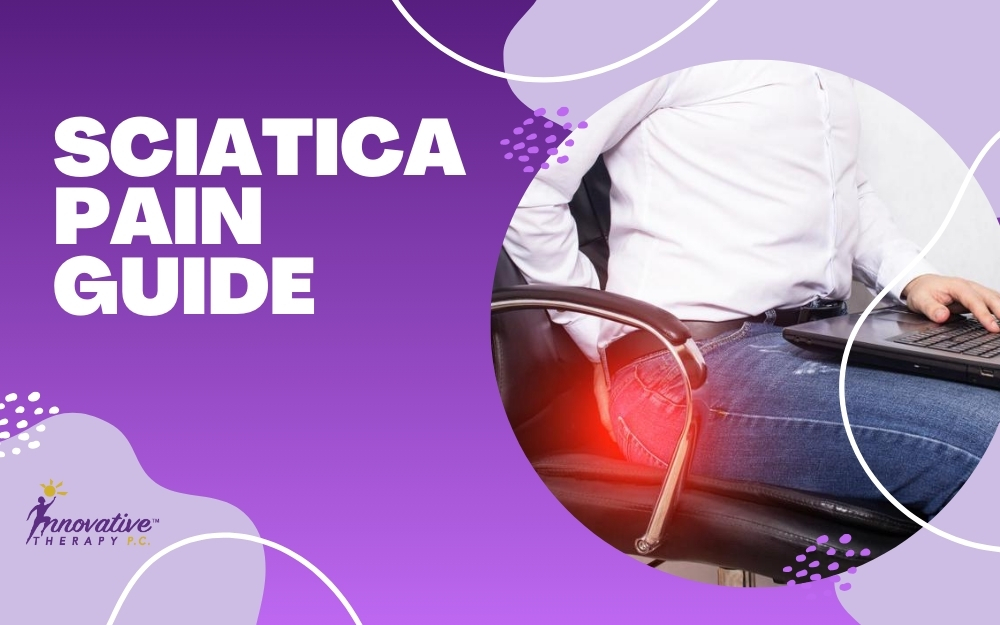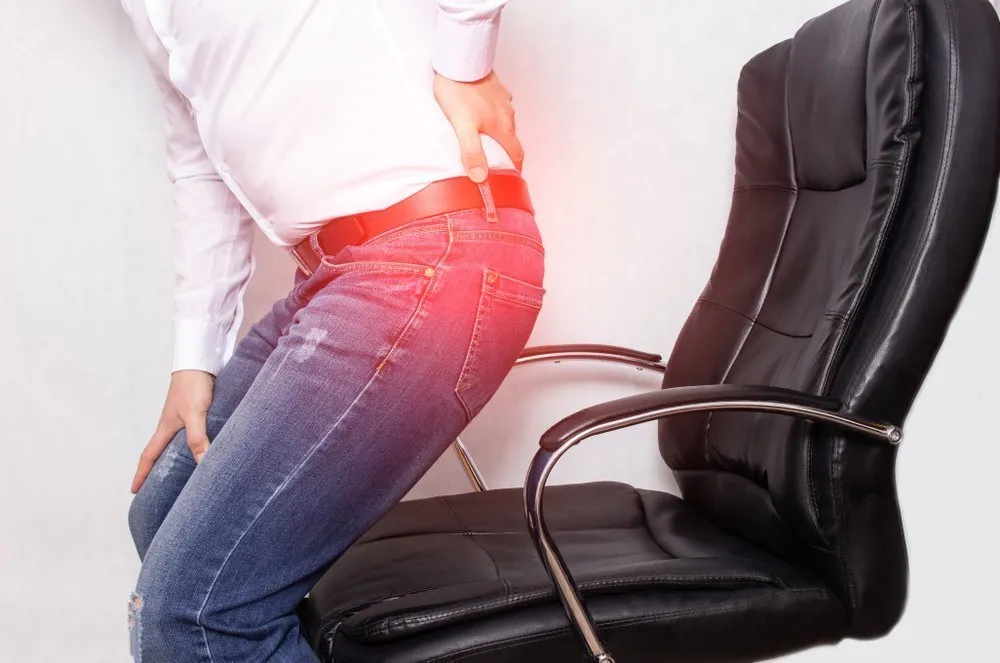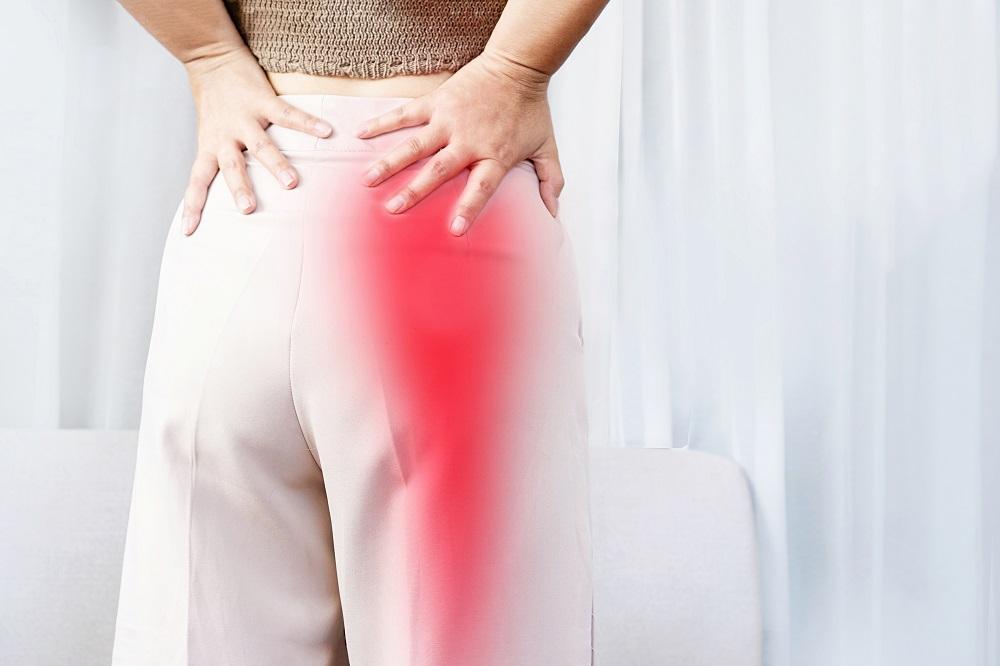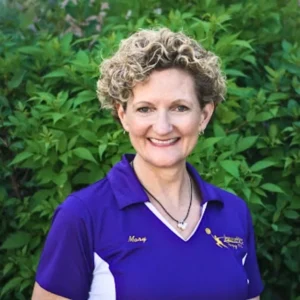Navigating the maze of sciatica can often be a daunting endeavor.
With an array of symptoms, causes, and treatments, where does one even begin?
Welcome to the ultimate “sciatica pain guide,” a comprehensive exploration tailored to demystify this prevalent ailment.
From understanding the tell-tale “Sciatica Pain Symptoms” to discovering effective “sciatica pain treatment” options, this guide is designed to be your beacon in the vast ocean of back pain information.
Step in, and let’s embark on this journey to unravel the mysteries of sciatica and empower you with knowledge and solutions.
What is Sciatica?

Sciatica is more than just a term thrown around to describe back pain. It specifically refers to pain that radiates along the path of the sciatic nerve — the longest and largest nerve in the human body.
This nerve branches from your lower back, courses through the hips and buttocks, and then splits down each leg.
Sciatica isn’t a stand-alone medical condition but rather a symptom of an underlying issue affecting the sciatic nerve.
Typically, the pain is felt only on one side of the body, varying from a mild ache to a sharp, burning sensation or excruciating discomfort. Occasionally, this pain is accompanied by tingling, numbness, or muscle weakness in the affected leg or foot.
Sciatica or Other Back Pain?
It’s a common misconception that all back pain equates to sciatica. The truth is, while sciatica indeed manifests as back pain, not all back pain is sciatica. The hallmark of sciatica is the way the pain radiates downwards, following the trail of the sciatic nerve.
Other general back pains might be localized, without this distinctive radiation. To truly discern between sciatica and other types of back pain, one must pay attention to the nature, location, and radiation pattern of the discomfort.
Who Gets Sciatica?
Contrary to some beliefs, sciatica doesn’t play favorites. It can affect anyone, regardless of age, profession, or lifestyle. However, certain risk factors elevate its occurrence. Individuals between 30 to 50 years old are more prone to experiencing it.
This is attributed to the natural wear and tear of aging, especially on the discs of our spine. Physical factors, such as obesity, can increase the stress on the spine, thus raising the risk. Professions demanding excessive carrying, sitting, twisting or driving can also predispose individuals to sciatica.
Types of Sciatica – Sciatica Pain Guide
To grasp the full picture of sciatica in this Sciatica Pain Guide, it’s necessary to understand its categorizations.
Not all sciatica pain is the same, and thus, it’s been divided primarily based on its cause and presentation.
True Sciatica

Also known as primary sciatica, this form results directly from the irritation or compression of the sciatic nerve. Conditions like lumbar herniated discs, lumbar spinal stenosis, or degenerative disc disease often lead to true sciatica.
The pain is characteristically sharp and shooting, traveling from the lower back down the leg.
Sciatica-like Conditions
Some conditions mimic the symptoms of sciatica but have different origins. For instance:
- Piriformis Syndrome: The piriformis muscle, located deep in the buttock region, can sometimes spasm and irritate the sciatic nerve, leading to symptoms similar to true sciatica.
- Sacroiliac Joint Dysfunction: The sacroiliac joint, located at the base of the spine, can also irritate the L5 nerve root if inflamed, producing sciatica-like symptoms.
Understanding these distinctions is paramount, as treatment and prognosis can differ based on the root cause.
How Common is Sciatica?
Sciatica is far from a rare ailment. Research suggests that up to 40% of people will experience sciatica at some point in their lives. It’s a common reason for individuals to seek medical attention and, often, miss work or other daily responsibilities.
While it might be commonplace, its impact on the quality of life can be significant, making it a focal point of concern for healthcare professionals. Its prevalence emphasizes the importance of proper awareness, timely diagnosis, and effective treatment strategies.
Symptoms and Causes – Sciatica Pain Guide
To tackle sciatica effectively with this Sciatica Pain Guide, one must first understand its manifesting symptoms and underlying causes.
What are the Symptoms of Sciatica?

Sciatica’s symptoms are distinct, primarily because they follow the path of the sciatic nerve. Here are the classic manifestations:
- Radiating Pain: The most telling symptom is pain that radiates from the lower spine down the back of the leg. It can range from a consistent ache to a sharp, searing pain.
- Tingling or Numbness: Many people with sciatica experience a tingling sensation or numbness in the affected leg, sometimes even extending to the foot.
- Weakness: Muscle weakness in the affected leg can occur, making routine tasks more strenuous.
- Localized Lower Back Pain: While the hallmark of sciatica is radiating pain, some individuals might also experience localized pain in the lower back.
- Aggravated by Movement: Actions like sneezing, coughing, or prolonged sitting can exacerbate the pain.
- Unilateral Symptoms: Typically, sciatica affects only one side of the body. It’s rare for both legs to experience the symptoms concurrently.
Recognizing these symptoms early can pave the way for prompt treatment and relief. But what triggers these symptoms? Let’s delve into the causes of sciatica in the next segment.
Causes – Sciatica Pain Guide
The underlying causes of sciatica are diverse, and each contributes to the condition in unique ways. When any of the following conditions affect or put pressure on the sciatic nerve, the typical symptoms of sciatica can manifest.
Let’s figure out in this Sciatica Pain Guide.
Cause: Herniated Disk
A herniated disk, often referred to as a slipped or ruptured disk, is one of the most common causes of sciatica. The spinal column is made up of individual vertebrae cushioned by round, flat discs.
When these discs become damaged due to wear and tear or injury, the inner gel-like core can protrude out of its outer ring, exerting pressure on the surrounding nerve roots. If this herniation occurs in the lumbar region, it can irritate the sciatic nerve, leading to the characteristic pain of sciatica.
Cause: Spinal Stenosis
Spinal stenosis is characterized by the narrowing of the spaces within your spine, resulting in pressure on the nerves that travel through it. Lumbar spinal stenosis specifically affects the lower back.
The constriction can compress the roots of the sciatic nerve, causing sciatica-like symptoms. Age-related changes primarily cause this narrowing, making older adults more susceptible to developing spinal stenosis.
Cause: Spinal Tumours
Though rarer than other causes, spinal tumors are growths that form on the spine’s bones, ligaments, or nerve roots. As they grow, these tumors can infringe on the space occupied by the sciatic nerve, leading to compression.
The resulting pressure manifests as sciatica pain. It’s worth noting that both benign (non-cancerous) and malignant (cancerous) tumors can lead to these symptoms.
Cause: Piriformis Syndrome
The piriformis is a small muscle located deep in the buttock, close to where the sciatic nerve runs. With piriformis syndrome, this muscle spasms or becomes inflamed, often due to overuse or injury.
When it does, it can compress or irritate the sciatic nerve. The resulting symptoms closely mimic that of sciatica, even though the root cause is muscular rather than spinal.
Cause: Sacroiliitis
Sacroiliitis is an inflammation of one or both sacroiliac joints, which are where the lower spine and pelvis connect. Inflammation can arise from a range of conditions, such as arthritis, trauma, or even pregnancy. When these joints become inflamed, they can irritate the L5 nerve root located nearby, leading to sciatica-like pain.
Cause: Injury or Infection
Direct trauma to the sciatic nerve, perhaps from a car accident, fall, or even a surgical procedure, can lead to sciatica symptoms. Infections, although rare, can also cause inflammation in the region near the sciatic nerve, leading to compression and consequent pain.
Each of these causes underscores the complexity of sciatica. A thorough evaluation by professionals, like those at Innovative Therapy PC, can pinpoint the exact cause, paving the way for tailored treatment strategies.
Risk Factors – Sciatica Pain Guide

While anyone can develop sciatica, certain factors can increase the risk of encountering this condition. Recognizing these risk factors can help individuals adopt preventative measures:
- Age: As we age, natural wear and tear occur, leading to conditions like herniated disks or spinal stenosis, which are direct causes of sciatica.
- Occupation: Jobs that demand heavy lifting, twisting the spine, or driving for extended periods can elevate the risk of developing sciatica.
- Sedentary Lifestyle: Prolonged sitting or a lack of regular exercise can make one more susceptible to sciatica. This is especially true for individuals who have long desk jobs or watch television for extended hours.
- Obesity: Excessive body weight can contribute to spinal changes and increased stress on the spine, leading to conditions that cause sciatica.
- Diabetes: This condition affects the way the body uses blood sugar and can increase the risk of nerve damage, including the sciatic nerve.
- Tobacco Use: Smoking or other forms of tobacco consumption can weaken the spine and increase the risk of herniated disks.
Complications of Sciatica – Sciatica Pain Guide
If left untreated, sciatica can lead to several complications:
- Persistent Pain: The most obvious complication is persistent, often debilitating pain that can interfere with daily activities.
- Loss of Feeling: Some people might experience numbness in the affected leg, and this can become permanent.
- Weakness: Muscle weakness can become pronounced over time, making routine tasks more strenuous.
- Loss of Bowel or Bladder Control: In severe cases, compression of the sciatic nerve can lead to loss of bowel or bladder control, a condition termed cauda equina syndrome. This is a medical emergency and requires immediate attention.
Pregnancy And Sciatica – Sciatica Pain Guide

Pregnancy introduces various changes to a woman’s body, some of which can predispose them to sciatica. As the fetus grows, it can press against the sciatic nerve, leading to symptoms.
Additionally, the increased weight and changes in the center of gravity can strain the back, making a pregnant woman more susceptible to herniated disks. Hormonal changes during pregnancy can also lead to inflammation of the sciatic nerve.
It’s worth noting that while sciatica can make pregnancy more uncomfortable, it typically doesn’t pose any direct risk to the fetus.
However, for the well-being of the mother, it’s essential to discuss any sciatica-like symptoms with a healthcare provider, such as the experts at Innovative Therapy PC, to explore safe and effective treatment options.
Diagnosis and Tests – Sciatica Pain Guide
As with any medical condition, a proper diagnosis is the foundation for effective treatment. Pinpointing the cause of sciatica is essential, as it guides therapeutic interventions and helps determine the prognosis.
How is sciatica diagnosed?
The diagnosis of sciatica begins with a comprehensive history and physical examination:
- Medical History: The physician will ask about the nature, onset, duration, and severity of pain. Details like activities that alleviate or aggravate the pain, any previous episodes, and any associated symptoms will be discussed.
- Physical Examination: The physician might conduct several tests to check muscle strength, reflexes, and assess pain during various movements. The Straight Leg Raise test, where the patient lies on their back, and the doctor lifts the leg upward, is a classic test for sciatica. Pain during this movement often suggests sciatica.
- Neurological Examination: Checking for numbness, muscle strength, and reflexes can help identify the nerve that’s affected.
What tests will be done to diagnose this condition?
While the medical history and physical examination are often sufficient to diagnose sciatica, imaging and other tests can help confirm the diagnosis and pinpoint the cause:
- X-ray: It provides images of the bones and can show if there’s any narrowing of the spinal canal or if a bone spur is pressing on the sciatic nerve.
- MRI (Magnetic Resonance Imaging): An MRI produces detailed images of the bones and soft tissues like discs, muscles, and nerves. It can help visualize herniated discs, tumors, or any other abnormalities pressing on the sciatic nerve.
- CT Scan (Computed Tomography): By using X-rays to produce cross-sectional images, CT scans can highlight any herniation or bone spurs affecting the nerve.
- Electromyography (EMG): This test measures the electrical activity of muscles. An EMG can verify if sciatica is due to a herniated disk or another condition like piriformis syndrome.
Management and Treatment – Sciatica Pain Guide

Successfully managing and treating sciatica involves a multi-faceted approach. Given that the pain and discomfort arise from nerve irritation, exercises specifically designed to release the pressure on the sciatic nerve can be immensely beneficial. These exercises promote mobility, reduce inflammation, and often provide significant relief.
Sciatic Nerve Exercises
Sciatic nerve exercises primarily focus on stretching the muscles that might be compressing the nerve, particularly those in the lower back and glutes. Here are some effective exercises that are often recommended in this Sciatica Pain Guide:
1. Reclining Pigeon Pose
This yoga pose is known for opening the hips:
- Lie on your back and bring your right leg up to a right angle. Clasp both hands behind the thigh, locking your fingers.
- Lift your left leg and place your right ankle on top of the left knee.
- Hold the position for a moment. This helps stretch the small piriformis muscle, which can sometimes become inflamed and press against the sciatic nerve causing pain.
- Repeat on the other side.
2. Sitting Pigeon Pose
A variation of the reclining pigeon pose:
- Sit on the floor with your legs stretched out straight in front of you.
- Bend your right leg, placing your right ankle on top of the left knee.
- Lean forward and allow your upper body to reach towards the thigh.
- Hold for 15 to 30 seconds. This stretches the glutes and lower back.
- Repeat on the other side.
3. Forward Pigeon Pose
- Begin on all fours in a tabletop position.
- Bring your right knee forward and let it rest behind your right wrist. Your right foot should be just in front of your left hip.
- Slide your left leg back as far as comfortable, keeping your hips square to the floor.
- If your hips are more open, inch your right foot away from you. Ensure that your right shin rests on the floor.
- Slowly lower your upper body over your front leg, resting your forearms on the floor.
- Stay here for anywhere from 30 seconds to a couple of minutes.
- Repeat on the opposite side.
4. Knee to Opposite Shoulder
This simple stretch helps relieve sciatic pain by loosening your gluteal and piriformis muscles:
- Lie on your back with your legs extended and your feet flexed upward.
- Bend your right leg and clasp your hands around the knee.
- Gently pull your right leg across your body toward your left shoulder. Hold it there for 30 seconds and remember to pull your knee only as far as it will comfortably go.
- Push your knee so your leg returns to its starting position.
- Repeat for a total of 3 reps, then switch legs.
5. Standing Hamstring Stretch
This exercise targets the hamstrings, which can get tight and exacerbate lower back pain:
- Stand upright and place one heel on a surface that’s between 4 to 9 inches high.
- Flex your foot so your toes and leg are straight. If your knee tends to hyperextend, keep a slight bend in it.
- Bend your body forward slightly toward your foot. The further you go, the deeper the stretch. Do not push so far that you feel pain.
- Ease the hip of your raised leg downward as opposed to it lifting up.
- Hold for at least 30 seconds, then switch sides.
- Repeat 3 to 5 times on each side.
These exercises can be effective in alleviating sciatic pain. However, they should be done gently and gradually. It’s crucial to consult with a physical therapist, such as those at Innovative Therapy PC, before starting any new exercise regimen to ensure they’re suitable for your specific condition.
Conservative Treatments – Sciatica Pain Guide

Before delving into aggressive interventions, many healthcare providers advise starting with conservative treatments for sciatica. These approaches are generally safe, cause minimal side effects, and can be significantly effective in managing the symptoms.
Sciatica Relief: Ice and Heat
Using cold and hot packs can help reduce inflammation and relieve sciatica pain.
- Ice Packs: During the initial phase (first 48 hours) of sciatic pain, apply an ice pack to the painful area for 15-20 minutes several times a day. Cold helps reduce inflammation and numbs the area, providing immediate relief.
- Heat Packs: After 48 hours, switch to heat. A warm bath or a heating pad can ease muscle tension and spasms, promoting healing by increasing blood flow to the area. Make sure not to apply heat directly to the skin; always use a cloth or towel as a barrier.
Switching between heat and cold – known as contrast therapy – can also be effective for some individuals.
Sciatica Relief: Medication
Several types of medications can be beneficial:
- Over-The-Counter Pain Relievers: Nonsteroidal anti-inflammatory drugs (NSAIDs), such as ibuprofen or naproxen, can help reduce inflammation and alleviate pain.
- Prescription Medications: In cases of severe pain, doctors might prescribe muscle relaxants, narcotics, or drugs effective against nerve pain, such as gabapentin or pregabalin.
- Antidepressants: Tricyclic antidepressants can be effective in treating chronic low back pain.
Always consult with a healthcare provider before starting any medication.
Sciatica Relief: Stretching
Stretching can alleviate sciatic pain by relaxing tight muscles and improving flexibility. It’s crucial to ensure that stretches are done correctly to prevent further injury:
- Gentle back stretches
- Hamstring stretches
- Pigeon poses (as previously discussed)
Consistent stretching, ideally under the guidance of a physical therapist, can prevent recurrences of sciatica pain.
Sciatica Relief: Injections
If conservative treatments do not provide adequate relief, a healthcare provider might suggest corticosteroid injections:
- Epidural Steroid Injections: These injections can suppress inflammation around the irritated nerve, providing relief. The effects can be temporary, but for some, they last several months.
Sciatica Relief: Surgery
Surgery is considered when conservative treatments fail, or if there’s significant nerve compression leading to weakness, loss of bowel or bladder control, or severe pain:
- Microdiscectomy: A procedure where the portion of the herniated disc pressing on the sciatic nerve is removed. It’s a minimally invasive procedure with a high success rate.
- Laminectomy: In cases of spinal stenosis, part of the vertebra – called the lamina – is removed, creating more space for the nerves.
Surgery always carries some risks, so it’s vital to discuss potential benefits and drawbacks with a surgeon.
At Innovative Therapy PC, we believe in a comprehensive approach, starting with conservative treatments and moving to more aggressive interventions only when necessary. Effective management ensures patients can resume their daily activities with minimal discomfort.
Possible Complications or Side Effects of Treatment

Every treatment, whether conservative or aggressive, has its potential complications or side effects. At Innovative therapy we focus on conservative treatments which are safe and effective.
- Muscle Soreness
- Mild Bruising
- Fatigue
It’s essential to understand these risks and discuss them with your healthcare provider. The team at Innovative Therapy PC emphasizes clear communication to ensure patients are fully informed. If conservative treatment are not effective for you, we can refer you to healthcare providers who can take it to the next step.
How Soon After Treatment Will I Feel Better?
The timeline for recovery varies depending on the treatment:
- Medication and Ice/Heat Therapy: Many individuals feel better within hours to days. However, it’s essential to follow the recommended dosage and guidelines.
- Movement Activities: Many individuals feel better within hours to days. However, it’s essential to follow the recommended instructions.
- Manual Therapy: Many individuals feel better Immediately. However, it’s essential to combine manual therapy with movement activities to retrain the movement patterns.
Prevention – Sciatica Pain Guide
Prevention is always preferable to treatment. Here are some preventive measures:
- Exercise Regularly: Keeping your back strong helps support your spine. Low-impact activities, such as walking or swimming, can strengthen the muscles of the back without straining the sciatic nerve.
- Maintain Proper Posture: When sitting, use a chair with proper lower back support or place a pillow behind your lower back. Keep your feet flat on the floor.
- Lift Properly: Always use your legs, keeping your back straight. Do not bend at the waist when picking something up.
- Avoid Prolonged Sitting: If your job involves sitting for extended periods, stand up, stretch, and walk around every hour.
- Manage Your Weight: Extra weight can strain your back, leading to sciatica symptoms.
- Stay Active: An active body is crucial in preventing many health issues, including sciatica. Regular stretching, particularly of the lower back and hamstring, can be especially beneficial.
Incorporating these preventive measures, especially when combined with regular check-ins with a specialist from Innovative Therapy PC, can go a long way in keeping sciatica at bay.
Outlook / Prognosis – Sciatica Pain Guide

Sciatica, while often debilitating, typically has a favorable prognosis. Most individuals will recover with conservative treatment, and the need for surgical intervention remains relatively low. The duration and recovery trajectory, however, can differ based on the underlying cause and individual circumstances.
What Can I Expect If I Have Sciatica?
If you’ve been diagnosed with sciatica, here’s what you can generally expect:
- Pain Location and Intensity: Pain typically radiates from the lower spine down one leg, possibly reaching the foot. It might feel like a mild ache, a sharp burning sensation, or even excruciating pain.
- Numbness or Tingling: You might feel numbness, tingling, or muscle weakness in the affected leg or foot.
- Worsening with Movement: Activities like coughing, sneezing, or prolonged sitting can intensify the pain.
With proper treatment, the intensity and frequency of these symptoms should reduce over time.
How Long Does Sciatica Last?
For most people, sciatica resolves in a few weeks with conservative treatments. However, the duration can vary:
- Acute Sciatica: Lasts 4-8 weeks. Most individuals fall into this category and will recover with non-invasive treatments.
- Chronic Sciatica: Persists longer than 8 weeks. This form might require more intensive treatment, and recovery can take longer.
When Can I Go Back to Work?
Your return to work will be contingent on the nature of your job and the severity of your sciatica:
- Sedentary Jobs: If you have a desk job, you might be able to return to work within a few days to a week, especially with ergonomic adjustments to your workspace.
- Physically Demanding Jobs: If your job involves heavy lifting or prolonged standing, you might need a more extended period, ranging from a few weeks to several months, depending on your recovery.
Always consult with your healthcare provider before resuming work, especially if you have concerns about aggravating your condition.
What’s the Outlook for This Condition?
For most, the outlook for sciatica is positive:
- Good Recovery: The majority of individuals with sciatica will recover fully in time, especially with timely and appropriate treatment.
- Recurrent Episodes: Some might experience recurrent episodes of sciatica, but these can often be managed and minimized with preventive measures and lifestyle modifications.
- Chronic Issues: A small percentage might develop chronic sciatica or experience complications, such as permanent nerve damage. In these cases, more aggressive treatments, including surgery, might be considered.
At Innovative Therapy PC, our goal is to guide patients towards the best possible outcome, focusing on both immediate relief and long-term wellness. Regular follow-ups and individualized care plans ensure that our patients remain on the path to recovery and overall well-being.
Living With Sciatica – Sciatica Pain Guide

Living with sciatica can be a challenge, but understanding how to navigate the condition can make a significant difference. It’s not just about managing pain but also recognizing when it’s crucial to seek medical attention.
When Should I See My Healthcare Provider, or When Should I Seek Care?
If you suspect you have sciatica, or if your symptoms persist or worsen, it’s essential to consult a healthcare provider for a proper diagnosis and treatment plan. Here are specific situations where you should seek care:
- Persistent Pain: If you experience consistent pain for more than a week, especially if it’s interfering with your daily activities.
- Sudden, Severe Pain: A sudden spike in pain or discomfort, especially after an injury or accident, warrants a visit to a healthcare provider.
- Loss of Sensation: If you notice numbness or a tingling sensation that doesn’t go away.
- Motor Function Issues: Difficulty moving your leg or foot, or weakness in the muscles.
- Pain after a Physical Injury: If your sciatica symptoms began after a physical incident, like a car accident or fall, it’s essential to get checked out.
- No Improvement with Home Remedies: If over-the-counter pain relievers, rest, and other home remedies don’t seem to help.
Remember, early intervention can often lead to better outcomes. At Innovative Therapy PC, our team of experts is trained to diagnose and provide individualized treatment plans tailored to your specific needs.
When Should I Go to the Emergency Room?
While most cases of sciatica can be managed with regular medical care, certain situations warrant immediate medical attention. Consider heading to the emergency room if:
- Sudden and Intense Pain: A sudden, unbearable pain can be a sign of a severe underlying issue.
- Bowel or Bladder Dysfunction: Loss of bowel or bladder control is a serious symptom and requires immediate medical attention. This could be a sign of cauda equina syndrome, a rare but severe condition that demands urgent intervention.
- Extreme Weakness: If you experience significant muscle weakness or can’t move your leg or foot at all.
- Associated Symptoms: If your sciatica is accompanied by other alarming symptoms, such as chest pain or shortness of breath.
Always prioritize your health and safety. When in doubt, seek medical advice. Living with sciatica might require patience and persistence, but with the right guidance and support, most individuals can navigate the condition and lead active, fulfilling lives.
Also Read Related To Sciatica Pain Guide
- 9 Effective Sciatica Pain Treatments – A Complete Treatment Guide
- Most Effective Sciatica & Lower Back Pain Exercises
Frequently Asked Questions About Sciatica Pain Guide
Navigating the complexities of sciatica can be daunting, which is why we’ve compiled this comprehensive FAQ guide. These questions reflect common concerns and misconceptions about the condition which we covered here in this Sciatica Pain Guide.
How do I get my sciatic nerve to stop hurting?
Non-surgical treatments like physical therapy, medication, hot or cold packs, and specific exercises can help relieve sciatica pain. In some cases, injections or surgery might be recommended.
What Are Red Flags for Sciatica?
Red flags include severe and sudden pain, loss of bowel or bladder function, pronounced weakness in the leg, and sciatica following a traumatic incident.
What Are the 4 Types of Sciatica?
The four primary types are acute sciatica, chronic sciatica, bilateral sciatica (affecting both legs), and recurrent sciatica.
What Is the Most Effective Painkiller for Sciatica?
NSAIDs (like ibuprofen) are commonly prescribed for sciatica pain. In more severe cases, stronger medications, muscle relaxants, or even narcotics may be recommended.
What is Recommended for Sciatica Pain?
Recommendations include rest, physical therapy, over-the-counter pain medications, stretching exercises, and avoiding activities that worsen the pain.
What Pain Do You Get With Sciatica?
Pain generally radiates from the lower back down one leg, possibly reaching the foot. It can vary from mild aching to sharp, burning sensations.
What can I expect if I have Sciatica?
You can expect pain, numbness, tingling, or weakness radiating down one leg, potentially intensifying with certain movements or positions.
How long does Sciatica last?
Acute sciatica usually lasts between 4-8 weeks. Chronic sciatica can last longer.
When should I see my healthcare provider, or when should I seek care?
If symptoms persist, worsen, or are accompanied by sudden pain, weakness, or bowel or bladder issues, it’s crucial to seek medical attention.
Can Sciatica occur down both legs?
While it’s more common in one leg, bilateral sciatica can affect both legs.
Does Sciatica occur suddenly, or does it take time to develop?
It can appear suddenly after an injury or develop gradually over time.
Can weight gain during pregnancy cause Sciatica?
Yes, the added weight and pressure on the spine during pregnancy can lead to sciatica.
How can I tell if the pain in my hip is a hip issue or Sciatica?
A healthcare professional can help differentiate between the two through physical examinations and tests.
Sciatica vs. radiculopathy — what’s the difference?
Both involve nerve root irritation. Sciatica is a type of radiculopathy where the sciatic nerve, specifically, is affected.
Should I rest if I have Sciatica?
While rest can help initially, prolonged inactivity can worsen symptoms. Movement and gentle exercises are beneficial.
Can Sciatica cause my leg and ankle to swell?
Swelling isn’t a typical symptom of sciatica. If experienced, consult a healthcare provider.
What is the fastest way to heal Sciatica?
A combination of rest, medication, physical therapy, and lifestyle modifications can expedite recovery.
What are the four stages of Sciatica?
The stages include acute, recovery, recurrent, and chronic stages.
What triggers sciatica?
Common triggers include herniated disks, spinal stenosis, piriformis syndrome, and injuries or infections.
For more personalized answers and treatment options, consider reaching out to Innovative Therapy PC. Our dedicated team strives to provide comprehensive care tailored to each individual’s needs.
What you really need to Know about Sciatica Pain
Hope this Sciatica Pain Guide helped your!
Sciatica can be a debilitating condition, but with the right understanding and approach, relief is attainable.
Early intervention, combined with a holistic treatment plan, is crucial.
At Innovative Therapy PC, we’re dedicated to offering tailored solutions for sciatica sufferers, ensuring that they can return to an active and pain-free lifestyle.
Whether you’re newly diagnosed or seeking ongoing management, remember that the right support can make all the difference.






One Response